White Decembrist: description, types and cultivation
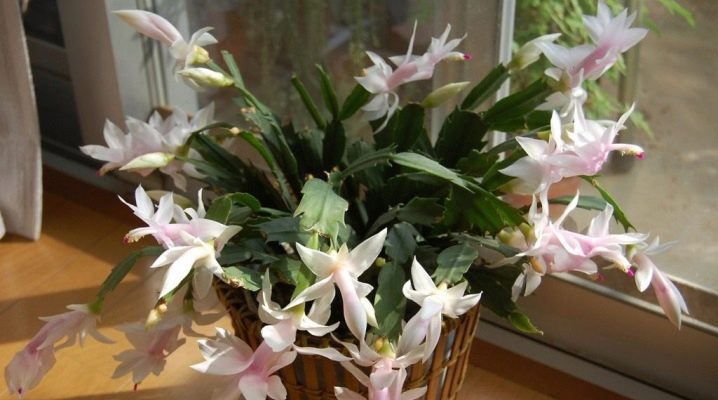
The Decembrist is valuable among those who are engaged in the cultivation of indoor crops. It is undemanding to growing conditions and has beautiful inflorescences that usually bloom in December, for which the plant got its name. This flower belongs to centenarians, has a varied form of bushes and various shades. One of the most beautiful species is the white Decembrist.
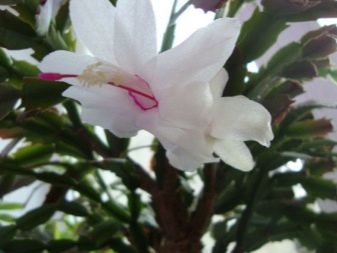

History
The Decembrist has several more names. Schlumberger is considered official. The following names are: zygocactus, rozhdestvennik and Varvarin krasa.
The Decembrist belongs to the cactus family. His homeland is the forests of the tropical climatic zone in Brazil. There it grows to this day on tree branches.
It was brought to European countries by the collector from Brazil Allan Cunningham in the 19th century.
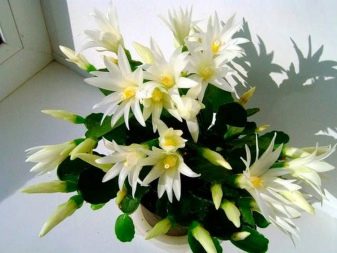

Plant characteristic
One of the main properties of the Decembrist is that it has the ability to accumulate liquid in the stems. In the natural environment, they grow on the trunks and root system of trees, but they do not belong to parasitic crops due to the fact that they do not draw sap from the trees where they grow. And they feed on moisture, which is formed when precipitation penetrates through the surface of the leaves.
Schlumberger's cacti are short bushes 20–35 cm long, each of which includes elements with jagged or round edges. Shoots are flat, serrated at the edges of each segment. No thorns. At the ends of the stems, buds are formed first, and then flowers of saturated colors. Not every insect has the ability to pollinate such a plant. In the native lands of the Decembrist, in the wild, flowers are pollinated by small birds - hummingbirds and one of the species of butterflies.
On the flower of this plant there are more than 25 petals up to 8 cm long. They can be narrow or wide, round or with sharp tips, ordinary or double. When the flowers bloom, they hang from the shoots and look very much like a waterfall.
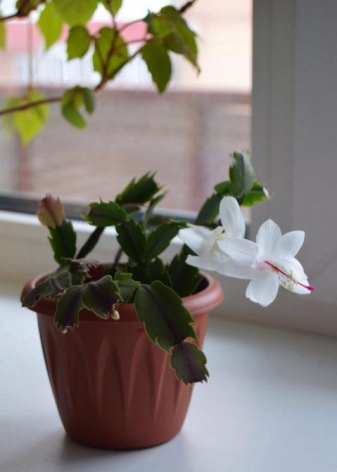
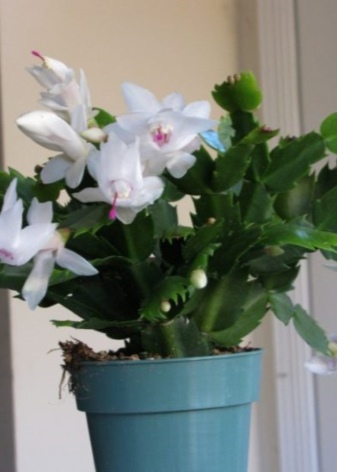
Types of white Decembrist
Among the variety of types of white Decembrist, the following are distinguished.
- White christmas... It is widely known throughout the world for its white flowers with pink stamens. The bush reaches up to 50 cm in height.
- Bridgeport - it is the most extraordinary of all types of zygocactus. It is represented by large flowers with elliptical petals. The bush is rather miniature.
- Madame butterfly... It is represented by inflorescences of white color, with a strip of pink color along the edges.
- Angel dance - a beautiful white flower with a white pistil. In other plants, the pistil is deep pink and this is not affected by the color of the flower. This species is considered albino and never appears pink.
- White bell - this variety is diminutive, and the flowers consist of two tiers.
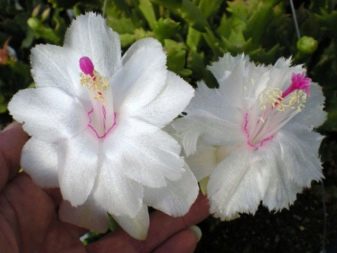
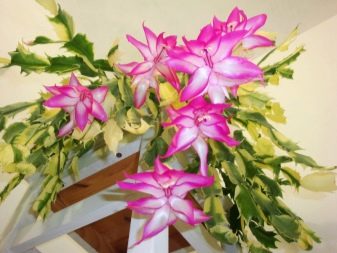
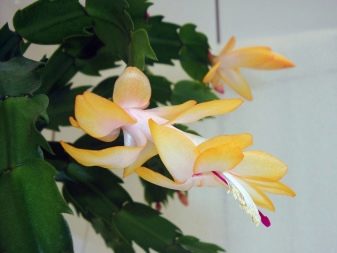
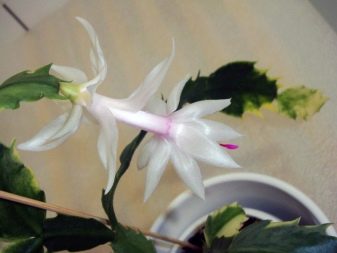
Hybrid varieties
Plants of this kind are famous for their unusual colors and more advanced qualities. They bloom much longer than other varieties. Flowers can combine several shades that smoothly transition from one to another.
Hybrids include Madame Butterfly. It has large flowers and shoots. The main feature of this variety is the flowering time. It starts one month earlier than in normal species.
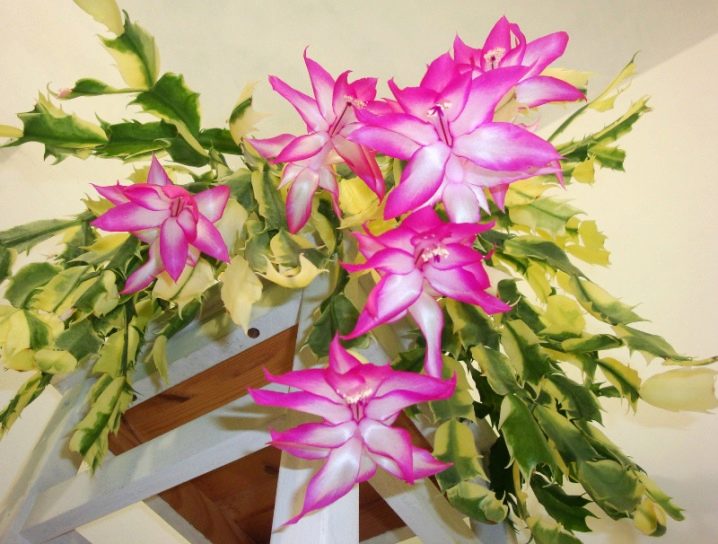
Another hybrid species is Malissa. It is characterized by short stems and voluminous flowers. Blooms quite profusely, within 4 months. The color is white with a purple center.The color can be changed in accordance with the temperature of the content. If the bush is kept in cool conditions, then the petals become pink.
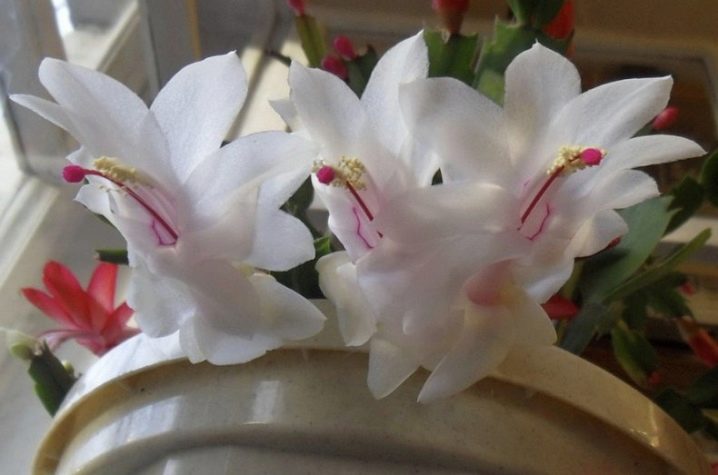
The various shades of Schlumberger are the result of painstaking work of breeders. At first, the plant had only pink and white petal colors, but now there are many varieties that are unlike each other.
Breeding at home
In the laboratory, researchers can even crossbreed different species of Decembrist. And at home, as an experiment, you can take plants of the same species, but different varieties.
At the initial stage, it is necessary to decide on the properties that the new plant should have. If there is a desire to get a Decembrist with white flowers at home, then plants with white flowers should be chosen as the ancestors. The selected crops should be free from damage and disease. One will be used as a pollinator, and the other will be used as a seed plant, on which a bud that has not yet opened is selected. Until it is opened, it is covered with a linen bag, and then all the stamens are cut off. This is done to prevent pollination by other flowers.
When the bud opens, pollen is applied to the flower. To do this, use a brush or cotton swab. Then they put on a linen bag again. To obtain positive results, the procedure must be repeated several times.
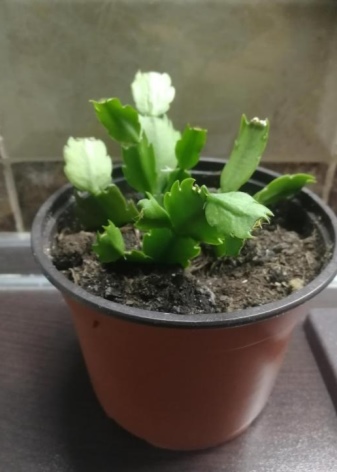
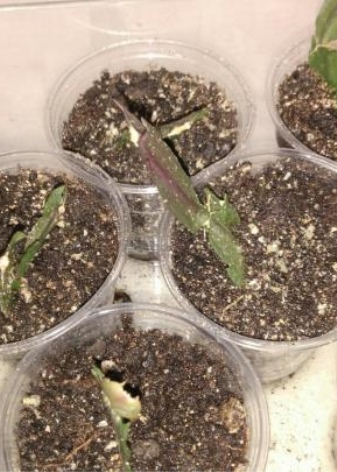
When seeds are formed, they are planted in the ground. Plants that have inherited the external appearance of one of the ancestors are not used for the next hybridization.
Care
Home care comes down primarily to watering. The Decembrist likes moderation in watering. When it blooms, you need to maintain the moisture content of the soil, and after watering it is reduced. In the summer, the Decembrist is watered only when the soil is completely dry. From the beginning of the autumn season until the buds appear, watering is also infrequent. During extreme heat, the Decembrist can be sprayed, but only the soil so that the water does not stagnate. Direct sunlight is destructive for the Decembrist, so it is better to keep it in partial shade.
Zygocactus is undemanding to temperature conditions. Suitable for him is from +1 to + 38 ° C. Before flowering, he needs to create cool conditions - from +11 to + 18 ° C - and then he will bloom profusely.
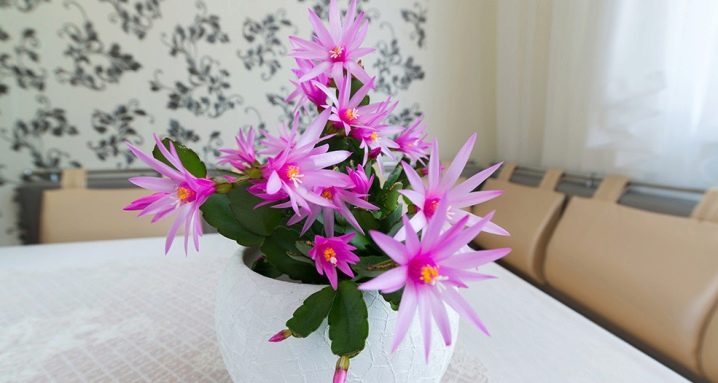
Periodically, the plant is pruned and transplanted. For transplanting, it is good to choose the time after flowering. For this, a low wide capacity is taken and drainage from small pebbles is laid on the bottom.
The substrate is prepared from peat, nutrient soil and sand in proportions of 2: 1: 1. The substrate should be light and loose.
The Decembrist is pruned in the summer to give it an attractive appearance. In the process, old shoots are removed, which spoil the appearance.
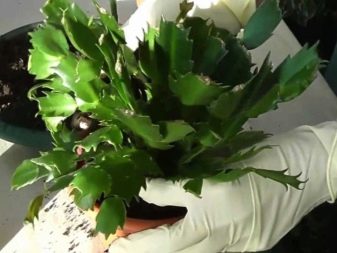

The Decembrist propagates by cuttings. Take cuttings on which the lowest sector has an aerial root. The stalk does not need to be cut off, it is easier to tear it off the stem, then it will branch better and take root quickly. After the cuttings are separated from the main plant, they need to be dried a little. In this case, the wound in the place of separation from the trunk should be covered with a glassy film.
The plant is unpretentious and does not require complex care. It can bloom for a long time. And if you adhere to the principles of plant care, you can get flowering bushes in the middle of winter.
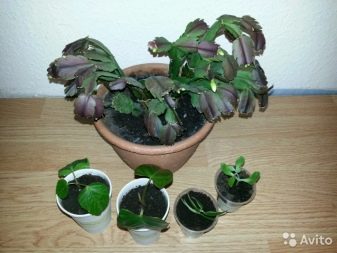

For information on how to care for a white Decembrist, see the video below.























































The comment was sent successfully.